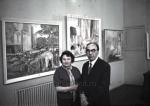|
|||
|
|||
|
|||



|
Artist
|
You can contact us via e-mail: info@labasfond.ru Alexander Labas left behind works that are an extraordinarily charming and wholesome 20th-century art phenomenon in its own right. The poetry and elegance of his artistic language and his unique resourceful imagination that easily overcame gravity and saw far beyond the ordinary routine make for the lasting modernity and invariable appeal of his works. Charged with vitality, his art developed according to its own scenario, ignoring the many obstacles that life persistently mounted along the way. Decades of neglect, isolation and exclusion from the freshly re-written history of young Soviet art followed right after the artist had won international recognition. This meant poverty and years of unsettled life. The only faithful friend by his side was his wife Leoni, who protected their small world, in which a universe of colors and metamorphoses of his amazing art came into being. Alexander Labas possessed an orthodox devotion to art; his will and his belief in artistic quest, his disregard of timeserving gave him a reputation of an individualistic and strong perso-nality. Both romantic and meticulous, he generated images that belonged to the poetic as well as to the scientific. He was of a rare kind of prophetic artists (as attested by his Flights to the Moon of the 1930s) that created their own Universe. The art of this exalted dreamer and thoughtful philoso-pher attracts even the most jaded connoisseurs with its profound earnestness. The pictorial language of Labas, although distinctly individual, belongs to its time – the 1920 and the 1930s - the generation of the Society of Easel Painters (OST) - and of course to the tradition of the Russian avant-garde. This tradition unmistakably shows through the philosophy of the artist. However, his works were not merely an interpretation of the avant-garde but rather a complete revision of its legacy, transformed and given a new lease on life. Just like the avant-garde artists of the early 20th century, Labas was constantly extending the limits of his field of vision, striving for the unknown universe. The infinite space, spreading outwards beyond the borders of the visual, is the major object of his aesthetic quest. His works are filled with the air of freedom that grants a new scale of being, destroys the framework of the ordi-nary and the earthly, and raises dreams to the state of philosophic strategies. In the 1920s through the early 1930s the art of Labas, along with the other OST members, was linked to the idealistic Utopia of the first decades of the century. His works are charged with a longing for the future, in tune with the vitalist concepts, but highlighted with romantic overtones. The spaces that the artist creates are arranged along the axis of the vast timeline, governed by its flow and bound to the fu-ture. The turnaround of the 1930s put an end to the romantic elation, and with it died the utopian dreams of re-fashioning the world. However, for Labas it was the beginning of a new stage in understanding space through a combination of intuitive visions and scientific knowledge, intellectual and irrational. The artist studied works of Einstein and Tsiolkovsky, contemporary physics and psychology – the knowledge that was naturally incorporated into his pictorial language. He was not trying to “test harmony with algebra” but rather to disclose the hidden mechanisms of the universe, using global scientific progress to look beyond the rational and see the unforeseen. The artist’s reflections upon the Universe and Cosmos are by no means an amateur’s attempt to interpret science. Every painting and drawing embodies his awareness of the visible world being part of an infinite whole that cannot be reduced to any equation, however elaborate and precise. The existing forms are nothing but substance that the great cosmos was made of – this is the artist’s idea of infinite space that gives life to a countless variety of incarnations – physical and spiritual, real and imaginary. The paintings of Labas are full of constant movement that is the foundation of his pictorial experience of time and space. Although the language of his art is akin to the futuristic concept of plastic dynamism, Labas gives it a new emotional structure and meaning, placing it in a new con-text, with a much more personal and individual interpretation. He uses the themes of aviation and high speeds in hundreds of variations, with rising airplanes, zeppelins floating in the sky, trains rushing through space and cars speeding through the city streets being his favorite subjects. Smudged silhouettes, floating or multiplying outlines, easily penetrable forms, dissolving in the fluid atmosphere and reappearing again – in his works the corporal forms lose their coarseness and become part of one lucid spatial substance. The art of Labas leads the viewer into a world of dynamic sensations, constantly develop-ing and changing, and thus revealing the inherent affinity of his works to Henri Bergson’s concept of duration. “There is no form, because form is immobility, and reality is movement. The real is a constant change of form: form is but a momentary snapshot of transition”, - these words of the French philosopher perfectly illustrate the images created by Labas. His plastic forms are never immobile. Extending in time, these forms constantly evolve, mutate and penetrate each other, gain-ing the weightlessness of watercolors under the tender strokes of fluid brush that fills them with air, light and chromatic vibrations; forms drown in the pulsating, breathing substance that over-flows the painterly field. These works often bring to mind the paintings of Joseph Mallord William Turner with their manifestation of a single chromatic space that embraces all shapes and objects. But unlike Turner, Labas does not let the uncontrollable and wild natural chaos devour his painter-ly world. The elements of this world are of a different nature, always stabilized by rational think-ing and inspired by a romantic vision. With their edgy flying strokes, charged plasticity of shapes, sharp linear rhythm and color contrasts, some of the canvases bear a distinct imprint of expressionist art. Labas skillfully freed the poetic essence of expressionism from its ecstatic kinks, irrational and sickly grotesques. He cleared away the layers of wretched emotions to reveal luminous images. A musical ear is intole-rant to the cacophony of harsh and chaotic sound. Labas constructed clear harmonies of subtle poetry and lyrical instrumentation, letting the refined orchestra of images overcome expressionist dissonance. The artist freely combined the abstract with the figurative, emphasizing now their con-trast, now their similarity. Turning to the theories of Vassily Kandinsky, Labas experimented with rhythm and color, comparing visual and musical harmonies. In the juxtapositions of colors and lines, their interactions, now soft and delicate, now strained and edgy, he created a symphony of colors – music visualized yet retaining its essence. It is hard to imagine the artist’s work as some kind of straightforward evolution or simple linear progress. His art was developing in cycles, reverting to themes already known and gathering them into series, revising earlier subjects or turning back to the abstract and reproducing lost works. His boundless imagination was reinforced by the high standards that he applied to his own work – he wouldn’t let himself take a break from his constant quest. This ensured the high aesthetic level of each painting, drawing, study or sketch. His refined taste and masterful technique resisted any kind of imperfection. Each color area and each brushstroke that Labas applied to his canvases is based on careful reasoning. Even his signatures form part of a composition. The ease and spontaneity are rather an illusion created by the master: the living fabric of his works is charged with inner meaning that has remained topical to our day. |
↑ Наверх








